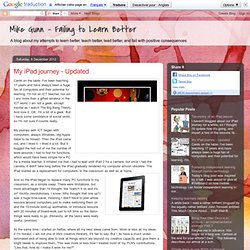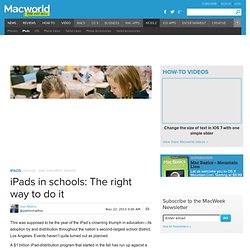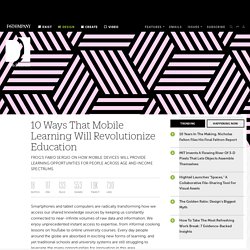

The Impact of New Technology in Schools – Results are in! My iPad journey - Updated. Cards on the table: I've been teaching 17 years and have always been a huge fan of computers and their potential for learning.

I'm not an ICT teacher, nor am I any more than a gifted amateur in the ICT world. I am not a geek, except insofar as I watch The Big Bang Theory. And love it. OK, I'm a bit of a geek. But I have some semblance of social skills, so I'm not sure it counts really. My journey with ICT began with computers, always Windows, big Apple hater to be honest. And so the iPad began to replace many PC functions in my classroom, as a simple swap. At the same time I started on twitter, where all my best ideas came from. Our school has been on a three-year drive to improve AfL, and this was brilliantly served by Socrative quick tutorial here if you've never seen it before), which had the advantage of being usable on computers and phones as well, useful for classes where we didn't have enough iPads to go round.
iPads in schools: The right way to do it. This was supposed to be the year of the iPad’s crowning triumph in education—its adoption by and distribution throughout the nation’s second-largest school district, Los Angeles.

Events haven’t quite turned out as planned. A $1 billion iPad-distribution program that started in the fall has run up against a series of obstacles. Students hacked their way past the tablet’s security; parents raised concerns that they were liable for iPad damage; and the program ran into cost overruns. Put all that together and the result is that officials recalled the iPads while they rethink their plan. Reportedly, the conflict even put Superintendent John Deasy’s job in jeopardy at one point. “It’s an ambitious project, involving lots of money, so there were probably going to be some problems coming out of the gate,” said Michael Janofsky, managing editor of L.A. Www.tpck.org. Teaching and Learning with the iPad – a 3 Year Review (Part 2) Today we continue the article series from Franklin Academy Principal David Mahaley that we began Sunday.

In the first installment of this three-part review of the iPad in teaching & learning, we examined the administrator’s point of view. Today we learn about what teachers have experienced and on Thursday we will conclude with insights shared by students. The Teacher Over my 20+ years in education, I have been a part of numerous technology initiatives. What seems to make the implementation of the iPad into the classroom successful in terms of the instructor is the personalization of the devices to very specific instructional needs. Lesson 1 – Change of Habit There are fundamental differences that take hold when teaching in the classroom with the iPad. “Once I became used to using the iPads in the classroom I took a different approach to planning. Instructors have recognized the need for production of materials with an anytime-anyplace access approach. Lesson 2 – Success is in the Support. Www.tpack.org.
10 Ways That Mobile Learning Will Revolutionize Education. Smartphones and tablet computers are radically transforming how we access our shared knowledge sources by keeping us constantly connected to near-infinite volumes of raw data and information.

We enjoy unprecedented instant access to expertise, from informal cooking lessons on YouTube to online university courses. Every day people around the globe are absorbed in exciting new forms of learning, and yet traditional schools and university systems are still struggling to leverage the many opportunities for innovation in this area. Recently frog has been researching how learning models are evolving—and how they can be improved—via the influence of mobile technologies.
We’ve found that the education industry needs new models and fresh frameworks to avoid losing touch with the radically evolving needs of its many current and potential new constituencies. We have been focusing on the concept of mLearning—where "m" usually stands for "mobile" but also just as easily for "me. " 1. 2. How Tablets Can Make You A More Effective Teacher. Have you ever finished teaching a lesson and thought to yourself: “That was a slam dunk!” , only to find out later that students did not retain your lesson as you had anticipated? Teaching is a secluded profession, in which teachers spend much of their day in adult solitude, but almost certainly requires more feedback than the majority of other occupations. So the question is raised, “How can teachers better assess their teaching in this solitude?” In today’s world of video recording capabilities, it only seems fitting to utilize this advanced technology to record one’s teaching. Teachers can use classroom video recording much like athletes do.
This self-assessment technique has proven to give athletes a better understanding of their attributes as well as a comprehensive realization of their weaknesses. Figuring Out What To Improve The integration of Tablets as an assessment tool helps to answer the question: “How can a teacher improve something, if they are not sure what to improve?”